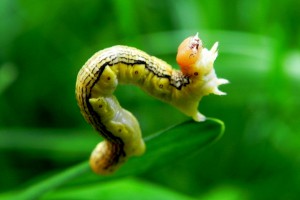Every summer, they arrive. Little green worms, dropping from threads and spinning in the breeze. While one or two of these little insects can seem cute, when they multiply, they can cause real damage to our trees and shrubs.
Inchworms go by many different names, including cankerworms, spanworms, loopers, and measuring worms. Generally reaching one inch in length, they can be any color from white to green or black and are smooth and hairless. To find out if your have inch worms, you can lightly shake plants to check for worms and larvae, or you can carefully examine branches for signs of infection. Infected plants will have noticeable tiny and irregularly shaped holes between the veins.
Having a few inch worms is not destructive to the natural habitat since many trees and plant life can survive minimal inchworm feeding. However, when the number of inchworms grows and you have an Inchworm infestation they can become a destructive pest, often damaging vegetable crops and ornamental trees, shrubs and flowers. The inchworm can be particularly destructive once an infestation is present because female moths lay their eggs in both fall and spring cycles.
What do they eat?
The type of foliage the inchworm feeds upon will depend on its species. Some prefer trees and shrubs. These inchworms cause damage on apple trees, oaks, and sweet gums. Other species of inchworm prefer vegetable gardens, and will feast upon almost any vegetable you plant, including tomatoes, celery, beans, potatoes, cabbage, and radishes.
Prevention& treatment
The best type of prevention of an inchworm infestation is making sure your lawn or garden is hospital to the inchworm’s natural predators. Ground beetles, birds, Trichogramma wasps, yellow jackets, and paper wasps all prey upon the inchworm. So feeding songbirds, and installing birdhouses is a great way to get ahead of the problem.
However, if the infestation is large enough to present significant damage, you may opt to hire a professional to take care of the problem. A professional extermination company may use any number of treatment options. Horticultural oils can be applied to trees, and Bacillus thuringiensis for vegetable gardens; oils will smother the worms, while Bacillus thuringiensis will cause the body of the worms to rot, while being harmless to humans. These methods may not work once the inchworm is larger than 1/2 inch, however, and inthat case, chemical insecticides may be needed to control the infestation.
